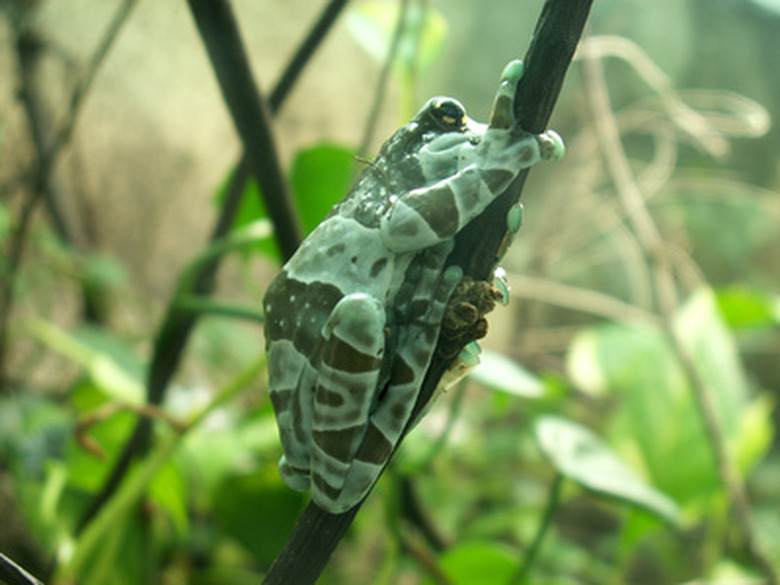How Plants And Animals Interact In The Rain Forest
The climate within rain forests is warm, with much rain through most of the year, which makes the landscape responsive to animal and plant interaction. Rain forests are home to a large number of plant and animal species. A variety of animals, birds and insects subsist together in adaptive surroundings. The plants, shrubs, flowers and streams provide food and drink for the animals. Microbial activity and mixed mulch enrich the soil, thereby promoting healthy plant growth.
Rain Forests--a Blend of Numerous Groups
Rain Forests–a Blend of Numerous Groups
Scientists believe that the tropical rain forests of the world might hold up to 90 percent of the plant and animal species on earth, according to the sps.lane.edu online article Tropical Rainforest Biome: Rain 3.
The Amazon River feeds the world's largest tropical rain forest. There are approximately 3,000 species of fish in the river. The Rain 3 article states that a typical patch of rain forest measuring 6 kilometers square contains as many as 1,500 species of flowering plants, 750 species of trees, 400 species of birds, 150 species of butterflies, 100 species of reptiles and 60 species of amphibians. A 2.5-acre of the rain forest may contain as many as 42,000 species of insects, according to the Biome article.
Rain Forests Animal Security
Rain Forests Animal Security
Sensible nonverbal communication exists in the rain forests as smaller animals use the cover of plants for security and adapt to their surroundings. Since the forest is strewn with dead leaves, some animals use the leaves to effectively camouflage themselves against predatory animals searching for food. Moths, tree frogs and katydids, or long-horned grasshoppers, blend into the environment at will and become invisible.
Animals of the rain forests use bright coloring to warn predators that they are poisonous; however, in some cases, this move is simply a ruse to stay alive. Poison arrow frogs are colorful and truly poisonous. Some indigenous rain forest tribes use the poisonous secretion from the frogs to poison the tips of their blowgun darts as they hunt for food in the forest.
Vegetation and Animals
Vegetation and Animals
Vegetation is a constant presence in the rain forest. River tributaries running throughout the forest floor also collect water and serve as watering holes for animals. The rain runoff from trees provides a rich source of nutrition for trees and shrubs. Animals obtain nutrition from flowering trees and shrubs that bear seeds and fruits.
Smaller animals build their nests in thick overgrowth of thickets. Copious leaves on the forest floor combined with rainwater and microbial activity provide mulch to the soil. Plant growth is lush, and food supply for animals is abundant.
Animal and Plant Life–a Shared Culture
The Amazon River basin's rain forest contains a wider variety of plant and animal life than any other biome in the world, according to blueplanetbiomes.org. The online article "Animal Life" affirms that common characteristics found among mammals, reptiles, amphibians and birds in that biome include adaptations to a life in the trees. Other characteristics, it states, are bright colors and sharp patterns, loud vocalizations, and diets heavy on fruits from rain forest trees.
Animals and Plants Are Mutually Dependent
Animals and Plants Are Mutually Dependent
The lives of animals and plants are intertwined. The decline of one species creates a marked reduction for the other. Rainforest Biomes state that thousands of years of heavy rains have washed away the nutrients of rain forests. Nutrients in rain forests are found mainly in living plants and the layers of decomposing leaves on the forest floor.
Various species of decomposers, such as insects, bacteria and fungi, convert dead plant and animal matter into nutrients, according to Rainforest Biomes. Plants then absorb these nutrients, which promote tree growth to produce fruits and seeds in addition to leaves for the animals' diets.
References
Cite This Article
MLA
Clarke-Brown, Carmen. "How Plants And Animals Interact In The Rain Forest" sciencing.com, https://www.sciencing.com/plants-animals-interact-rain-forest-6672736/. 22 November 2019.
APA
Clarke-Brown, Carmen. (2019, November 22). How Plants And Animals Interact In The Rain Forest. sciencing.com. Retrieved from https://www.sciencing.com/plants-animals-interact-rain-forest-6672736/
Chicago
Clarke-Brown, Carmen. How Plants And Animals Interact In The Rain Forest last modified March 24, 2022. https://www.sciencing.com/plants-animals-interact-rain-forest-6672736/




